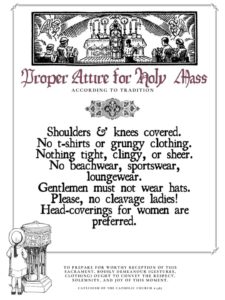What’s up with the dress code? It seems that people are more dressed up than usual. How should people dress for a traditional Latin Mass? Must men wear suits? Must women wear chapel veils (i.e. mantillas)?
You may notice that people tend to dress more formally at traditional Latin Masses than at ordinary form Masses in the United States. Most frequently, women wear dresses or skirts that cover the knees and blouses that cover the shoulders; men typically wear either shirt and tie or at least a collared shirt with pants. We dress more formally not because we are any holier than anyone else, but because this form of the liturgy so inspires us to wear our very best for the King of Kings.
Coming to church modestly and decently dressed is a concrete way to honor the dignity of God’s house, where Our Lord dwells in the tabernacle. Revealing or tight-fitting clothing does not meet the norms for Christian modesty.
Gentlemen and boys are encouraged to wear slacks (no shorts, please) and at least a collared polo shirt in warm weather and a button-down or dress shirt is always appropriate any time of year. Sport coats and suits are also welcome.
Thank you for expressing your love for God’s house and edifying your neighbor by your respectful demeanor and attire in church.
At most traditional Latin Masses, you may notice that many women wear hats or veils. These head coverings are an ancient custom from the time of Paul to today (see 1 Cor 11:1-17). There are several devotional reasons for this tradition. For example, wearing a head covering is an expression of modesty and chastity in imitation of our Lady, who is rarely depicted without her veil. Furthermore, wearing a head covering also can indicate humility and submission before the Blessed Sacrament. Finally, head coverings promote respect for women and their distinct gifts. Like the chalice and the ciboria that are veiled, women are veiled because they are all vessels of life, supernatural and natural.
While it is a laudable and pious practice, it is also not a sin to refrain from this devotion. If you would like to wear one, a box of spare veils are available in the Communications Center located in the left rear of the church by the statue of the Pietá. Here is a short video on the tradition of veiling that may be helpful:
FAQ about Veiling (Courtesy of Veils by Lily)
- Why do Catholic women wear chapel veils at Mass?
- Why don’t men wear veils?
- When should I wear my chapel veil?
- Do I have to wear a lace mantilla? What about hats and other types of head coverings?
- Shouldn’t I avoid drawing attention to myself at Mass?
- I’m a bit worried about what other people might think if I wear a veil. What do you suggest?
- Did the Church do away with veils after Vatican II?
- I’m new to veiling. Is there a meaning behind veil colors?
- Does my hair have to be completely covered?
- How do I keep my veil from slipping off my head?
- At what age should my daughter start wearing a veil?
- Is it vanity to wear a beautiful lace mantilla?
- Should I wear a veil to someone else’s wedding?
